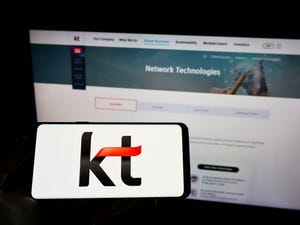Brit Startup Bonds Broadband
Sharedband unveils a new way of aggregating broadband line capacity and strikes a deal with BT
December 6, 2007

British startup Sharedband Ltd. claims to have developed a new technique to aggregate access line capacity that can provide small businesses and home office users with a broadband connection equivalent to, or better than, a leased line, at the fraction of the cost.
The technology has such potential to drive increased demand for broadband connections and business services (VOIP, videoconferencing, VPN) that BT Wholesale has agreed to provide Sharedband's technology to its British ISP customers. Those ISPs can then use the technology to sell bandwidth aggregation services and new broadband connections to their customers. (See BT Teams With Sharedband.)
BT's incentive is that any use of Sharedband's technology will likely generate extra demand for wholesale broadband connections and business services, as well as provide BT Wholesale with reseller commission revenues.
"Shareband's innovative technology allows ISPs to aggregate BT's high-speed rate-adaptive broadband services into a powerful proposition, enabling them to deliver more demanding bandwidth applications such as video and VOIP," said Guy Bradshaw, general manager of IPStream at BT Wholesale, in an email response to questions.
Broadband bonding at the IP layer
Sharedband has developed patented software that aggregates the downstream and upstream capacity of up to four broadband connections to create a virtual single connection of up to 16 Mbit/s that is aggregated at the IP layer. (Other broadband bonding technologies aggregate bandwidth at the physical layer.)
Key to Sharedband's proposition is that its software aggregates the capacity from any type of broadband connection -- DSL, cable, wireless -- from any number of service providers.
The main benefit to end users is that they get the equivalent of (or something better than) a leased line at the fraction of the cost and with built-in resilience, because the connection does not come with the risk of having a single point of failure.
So, if a small company has three broadband lines -- for instance, two DSL connections capable of 4 Mbit/s downstream and 500 kbit/s upstream, and a cable broadband connection capable of 8 Mbit/s downstream and 1 Mbit/s upstream -- the total capacity of those lines can be aggregated to give it a virtual single connection of 16 Mbit/s downstream and 2 Mbit/s upstream at a cost of up tot £120 (US$243) per month -- compared with at least four times that amount (but mostly a great deal more) for the cheapest synchronous 2-Mbit/s leased line (after setup costs).
In addition, by having multiple connections from different suppliers, the customer still has a working broadband connection should one of the lines lose service.
How it works
All this is achieved through the deployment of Sharedband software at the customer site and at the ISP's hosting site.
The ISP supplies the customer with the standard broadband end user products -- DSL modem, cable modem, WiFi router, but typically a Netgear Inc. (Nasdaq: NTGR) DSL router -- that has Sharedband's software pre-loaded. The software modifies the routers' firmware and enables them to communicate and be aware of other Sharedband agents on a LAN. One of the routers acts as a default gateway, sending the IP packets traffic over the best available broadband connection.
Sharedband says it can port its software onto just about any broadband router on the market, and that it has a development partnership with Netgear, whose end-user DSL routers are widely deployed.
The ISP providing the service installs Sharedband aggregation software onto a standard server at its hosting center. This aggregates the upstream IP packets and sends them on to the relevant IP network, and also routes downstream traffic across the customer's multiple broadband connections.
For more technical details about how Sharedband's technology works, check out How Sharedband Works and Sharedband features.
To Page 2
"We have developed management interfaces to make sure this is easy to roll out," says Sharedband CEO Paul Evans. "We've been working with ISPs for the past nine months to make sure our system meets their needs" before announcing a full-scale launch.
"We have to be sure we are meeting market needs -- we don't have the money for a false start," he adds. Sharedband is privately funded, with total backing of "way less than £1 million."
Market incentives
Evans, who ran the Internet Infrastructure Lab (IIL) at BT Group plc (NYSE: BT; London: BTA) prior to setting up Sharedband in 2003, says his company's software is supplied free to ISPs, which then sign up for a revenue-sharing agreement based on Sharedband service usage. The technology has been trialed by a handful of ISPs in the U.K. and has been used commercially by at least one, Warrington, England-based Talk Internet.
Evans believes the lack of expensive hardware and upfront cost, and the potential to sell additional broadband connections and business services, should generate interest among ISPs. "Other line-bonding technologies require expensive hardware at the customer's and ISP's premises, and then restricts the customer to a single operator's broadband service. Our technology does the bonding at the IP layer, so it doesn't require any additional hardware. It's designed to be a plug-and-play technology, and doesn't need an IT engineer on site the way other bonded technologies do," says the CEO.
Simon Jones, managing director at Talk Internet, which is marketing the service as an ADSL bonding solution, believes the startup's development work has paid off.
"It's very straightforward. We ship the routers to our users, they plug them in. and away they go. It's that simple. It does what it says on the tin. We have a handful of customers using it at the moment, including one that has bought more broadband connections so it can bond four lines together. We have sold more lines as a result," says Jones.
He says the additional cost, on top of broadband line charges, of subscribing to the Sharedband service is about an extra 10 percent to 35 percent to the end customer, depending on the setup, and that the main driver for demand so far is to increase upstream capacity to enable offsite backup of company data.
While not revealing any financial details about potential revenue-sharing agreements with ISPs or sales targets, Evans notes that the U.K.'s small businesses and home offices currently account for around 1 million of Britain's 14 million broadband connections, and that Sharedband believes between 20 and 30 percent of those users "would be looking for an affordable solution like this… This brings resilient, fast communications to the masses, enabling small businesses to gain the services benefits of large companies at a price they can afford."
Evans and his 13 staff aren't limiting themselves to the U.K. market. Two of the startup's employees are based in Seattle, and Sharedband plans to launch itself in North America during January 2008, though Evans won't confirm if a partner similar to BT Wholesale has been signed up for that market. "It's a different market to the U.K., but we are going indirect where we can," says the CEO.
— Ray Le Maistre, International News Editor, Light Reading
You May Also Like










